What to Do With Monstera Aerial Roots? Identification & Maintenance Tips
-
Pete Ortiz
- Last updated:
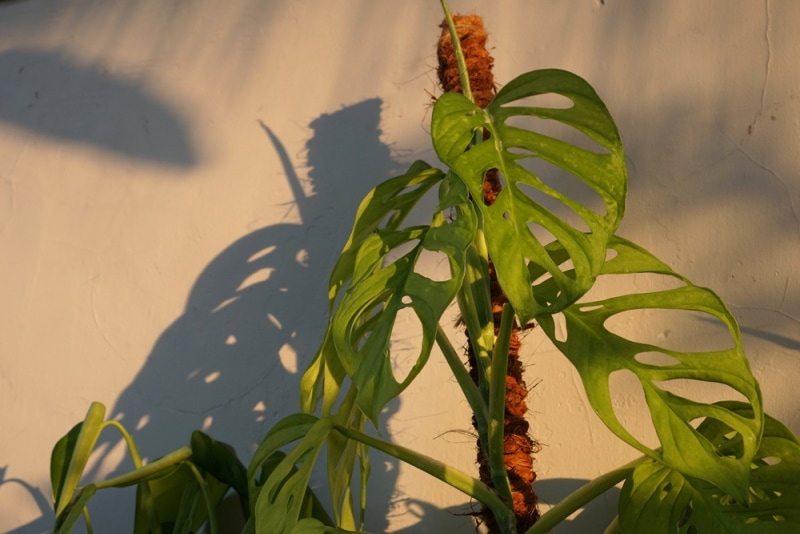
Lovers of indoor plants treasure Monstera aerial plants for their mature, fenestrate foliage, sometimes known as holey leaves. The native plants from South and Central America can be seen growing wild in dense forest undergrowth, extending long stems, vines, and aerial roots to avoid the shade of the thick canopy.
In addition to aiding the Monstera plant in clinging to trees, boulders, and cliffs in pursuit of additional sunshine, these elongated stems and roots are made to absorb water and nutrients. But that’s one unattractive feature of your houseplant because it makes the branch appear scraggly, unkempt, and out of control.
As a result, you must learn how to handle Monstera aerial roots, including removing or keeping these prominent, brown, stem-like protrusions. Read on to learn more about this plant, how to manage it, and how to handle these unsightly roots.
Topics covered in this article:
- What’s the Purpose of Monstera Aerial Roots?
- Recommendations for Dealing With Monstera Aerial Roots
- Distinguishing Monstera Aerial Roots From Lateral Underground Roots
- Can New Monstera Plants Be Produced From Aerial Roots?
What’s the Purpose of Monstera Aerial Roots?
The Monstera plant thrives in dense tropical and equatorial forest undergrowth in its natural habitat in the wild. It has developed specific traits to meet these obstacles because it encounters intense competition for sunlight, water, and other resources.
That makes the Monstera aerial plant a climbing plant since it scales trees or other obstructions while spreading its broad leaves above the undergrowth. It requires more roots, which appear beneath the leaf stem at a particular age and expand to the extent that they can find a place to take root.
The aerial roots of Monstera are highly absorbent, taking in moisture and nutrients from the environment whenever they come into contact with a surface. The taller the plant grows, the more roots it generates, which are needed to sustain and feed it. They also have pores for air exchange.
In addition, aerial roots are adventitious as opposed to lateral or subsurface ones, which means they develop in unusual locations on the Monstera plant rather than sprouting as usual. As a result, even indoors, these plants have a natural tendency to climb, adhering to any substantial pillar for that purpose.
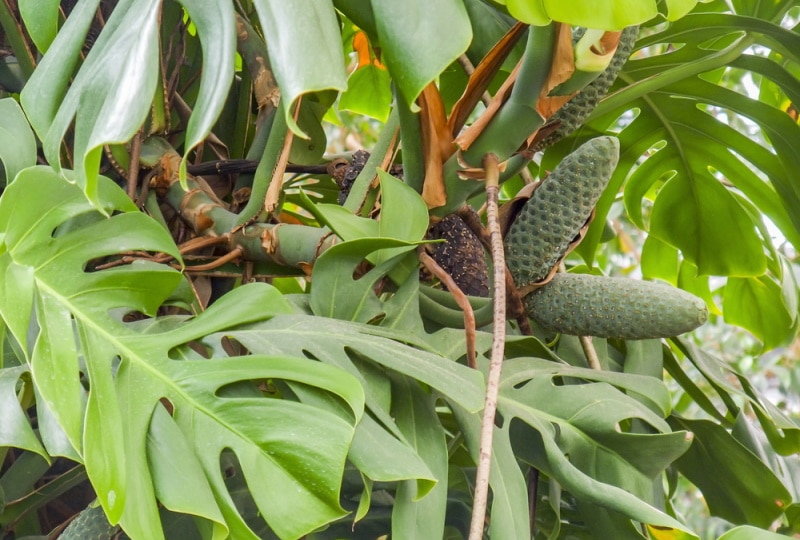
Recommendations for Dealing With Monstera Aerial Roots
To climb up trees or other supports in the wild and take in nutrients and moisture, Monstera plants naturally need aerial roots. These trailing protrusions, however, could seem pointless if the plant is a houseplant because climbing is optional or you have artificially supported it.
The aerial roots of your Monstera houseplant are a sign of good growth, not less light, moisture, or water in the area. Once the aerial roots of your Monstera plant appear, you don’t need to deal with them. However, as the plant develops, it will continue to elongate and become unsightly.
The aerial roots of Monstera plants can be dealt with in various ways, including letting them grow, controlling, or eliminating them.
You can do the following to improve your houseplant’s health and appearance:
- Misting or submerging the aerial roots in water
- Planting them back into the ground to become lateral roots
- Trimming and training them to tidy up
- Using the roots to propagate new plants
- Carefully pruning or cutting Monstera aerial roots
Misting or Submerging the Aerial Roots of the Monstera Plant
When a Monstera plant is young, its aerial roots begin green with light tips but eventually turn brown and woody, lengthen, and the plant gets taller. These roots develop nicely on their own. Therefore, it’s not necessary to put them in a water bowl, as some sources suggest.
If your environment has low humidity, you can softly sprinkle the aerial roots instead of submerging them in water, resulting in root rot or even the death of the entire plant. A humidifier close to the plant is also convenient since it stops the roots from growing longer in quest of more moisture.
Water in a bowl will be terrific if you’re seeking viable cuttings to produce new Monstera plants. Keep a close eye on the plant’s behavior after adjusting its care, especially since additional rot results from wetness.
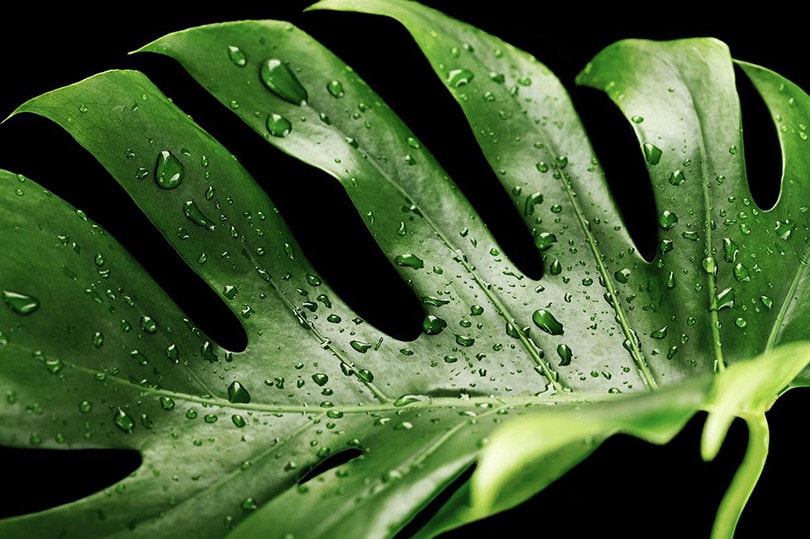
Replanting the Monstera Aerial Roots in the Ground
Monstera aerial roots spread out in quest of a sturdy surface. They gradually grow to the ground in the wild. While this increases the plant’s ability to absorb nutrients and water, you must train the houseplant’s roots to return to the soil so they can develop into lateral subterranean roots.
You can repot your Monstera houseplant into a bigger pot once you’ve given the roots time to extend sufficiently. The plant may suffer health effects or become root-bound if its roots grow too large for its container.
Cutting Off the Aerial Roots of the Monstera Plant
There is disagreement over whether you should cut off Monstera aerial roots because they don’t hurt the plant. If you don’t like how they look, chop them off completely. Although removing these roots will improve the appearance of your plant, you should take care to avoid harming the mother plant.
Cutting the Monstera plant exposes it to disease and pests by removing the outer protecting growth. Make your cuts with a clean, sharp instrument; avoid leaving jagged edges, tears, or rips on the plant because they complicate speedy healing and recovery.
To prevent harming the main plant while removing aerial roots from a Monstera plant, cut close to the stem and leave a small amount of root. By removing one or two roots and cutting them, you can gauge the plant’s response to reduced roots once it has recovered and cut off the rest.
Although aerial roots on Monstera will eventually regrow in the same spot, trimming or removing them may encourage the plant to generate new aerial roots.
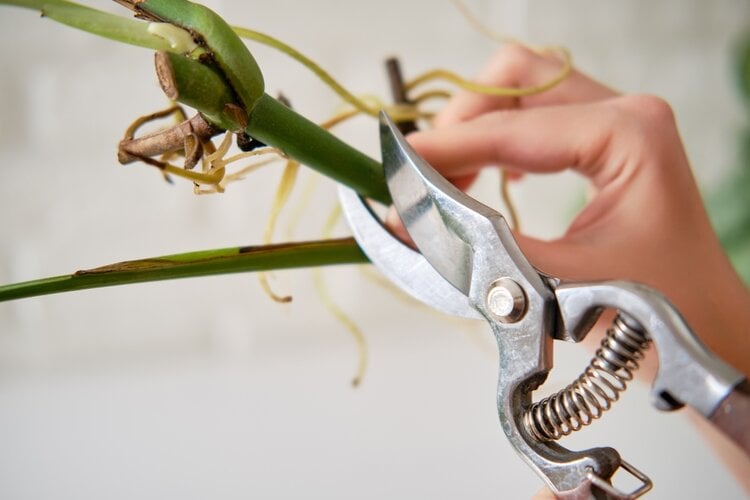
Getting Monstera Aerial Roots to Climb Posts or Other Structures
Monstera aerial roots that are out of control can be controlled by training them to moss posts, buildings, or other objects so the plant can climb higher. Using its aerial roots, you can let this plant climb up your wall, though it might chip off plaster or paint.
The most significant support for training your Monstera houseplant is a moss post since it resembles the mossy rocks and trees seen in the tropical wilderness. Because this plant needs a stout pole, make something strong to bear the weight as it expands.
To attach the Monstera plant’s stem to the post, use tape or plant ties, but keep them tight enough because that will hinder the plant’s regular growth. Avoid using thinner posts, such as bamboo. You can help the roots to take hold as the plant develops upwards by pruning the horizontal branches.
Distinguishing Monstera Aerial Roots From Lateral Underground Roots
The aerial roots growing from the plant stem may seem unusual if you’ve never propagated Monstera deliciosa at home. However, the plant utilizes these useful appendages for support, feeding, and aeration, which can support it without extra poles.
Aerial Monstera roots are tough and challenging to train, frequently shattering if you direct them in horizontal orientations. They also have a thick barky coating. Aerial roots are distinct from the subterranean lateral roots of Monstera.
Although they have a secondary role in absorbing moisture and air, aerial roots are primarily for support. They are adventitious, developing in odd places on the plant above ground, and can be guided back into the soil to become lateral roots.
They have extra raphide crystal cells, which produce the mildly poisonous oxalic acid found in plant tissue and which prevent animals from consuming them.
Unlike lateral roots that break or taper, aerial roots are rounder and continue to grow. They can develop into lateral roots if you train them in the soil, and you can also produce new Monstera plants from their cuttings because they are thick enough to have a more excellent hold on the supports they adhere to.
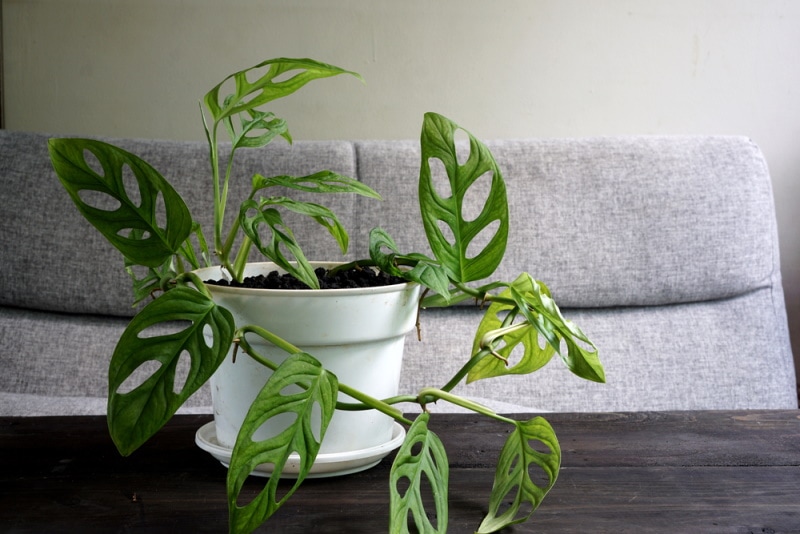
Can New Monstera Plants Be Produced From Aerial Roots?
The Monstera plant’s aerial roots can propagate other tiny plants, although this requires removing more than just the root. Take a piece of the stem with an aerial root or a node to start your new plant.
Placing the antenna is one method of spreading the root in a cup or bowl of water to increase its capacity to absorb nutrients and spur growth. Once it sprouts, make the cut and move it to a new pot. Regular water changes are necessary so it doesn’t become murky or hazy.
Another approach entails chopping off the portion of the stem with the aerial root or node and transplanting it right into soil that is suited for Monstera plant growth.
Similar to how orchids, philodendrons, and pothos are grown, you should water the new plant often to encourage root development in the new soil.
Conclusion
Due to its evergreen, variegated foliage with robust and upward-facing string stems, Monstera plants make ideal indoor plants. They create aerial roots that hang downward in quest of additional support when they grow significantly, so numerous aerial roots are produced by Monstera plants.
These roots help in support, nourishment, and water absorption for the healthy and quick growth of the plant. Although aerial roots are a sign of a healthy houseplant, you can better handle them if you find them ugly and untidy.
- Can Monstera Survive on Aerial Roots Alone If You Cut Off Its Underground Roots?
- What Should I Do If My Monstera Houseplant Fails to Produce Aerial Roots?
- Is the Health of My Monstera Houseplant Affected If I Trim Off All Its Aerial Roots?
- How Healthy Are Cuttings Derived From the Aerial Roots of a Monstera Plant?
- Why Bother Trimming Monstera Aerial Roots If They’ll Only Grow Back?
- How Can I Prevent My Monstera Houseplants Aerial Roots from Appearing Dry and Cracked?
- https://www.ohiotropics.com/2021/11/15/monstera-aerial-roots/
- https://planethouseplant.com/what-do-you-do-with-aerial-roots-on-monstera/
Featured Image Credit: johan kusuma, Shutterstock
Contents


